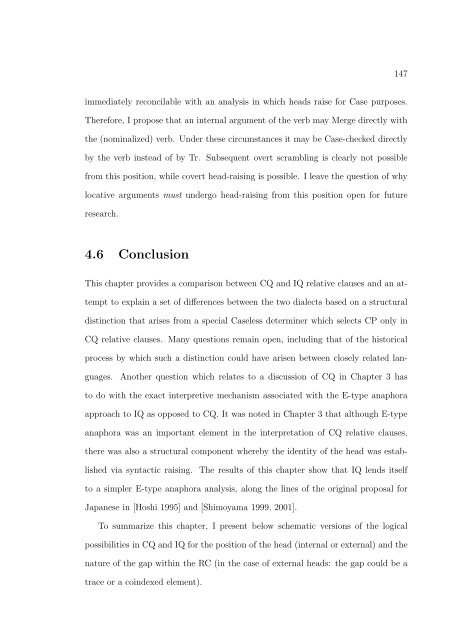the syntax and semantics of relativization and quantification
the syntax and semantics of relativization and quantification
the syntax and semantics of relativization and quantification
You also want an ePaper? Increase the reach of your titles
YUMPU automatically turns print PDFs into web optimized ePapers that Google loves.
147<br />
immediately reconcilable with an analysis in which heads raise for Case purposes.<br />
Therefore, I propose that an internal argument <strong>of</strong> <strong>the</strong> verb may Merge directly with<br />
<strong>the</strong> (nominalized) verb. Under <strong>the</strong>se circumstances it may be Case-checked directly<br />
by <strong>the</strong> verb instead <strong>of</strong> by Tr. Subsequent overt scrambling is clearly not possible<br />
from this position, while covert head-raising is possible. I leave <strong>the</strong> question <strong>of</strong> why<br />
locative arguments must undergo head-raising from this position open for future<br />
research.<br />
4.6 Conclusion<br />
This chapter provides a comparison between CQ <strong>and</strong> IQ relative clauses <strong>and</strong> an attempt<br />
to explain a set <strong>of</strong> differences between <strong>the</strong> two dialects based on a structural<br />
distinction that arises from a special Caseless determiner which selects CP only in<br />
CQ relative clauses. Many questions remain open, including that <strong>of</strong> <strong>the</strong> historical<br />
process by which such a distinction could have arisen between closely related languages.<br />
Ano<strong>the</strong>r question which relates to a discussion <strong>of</strong> CQ in Chapter 3 has<br />
to do with <strong>the</strong> exact interpretive mechanism associated with <strong>the</strong> E-type anaphora<br />
approach to IQ as opposed to CQ. It was noted in Chapter 3 that although E-type<br />
anaphora was an important element in <strong>the</strong> interpretation <strong>of</strong> CQ relative clauses,<br />
<strong>the</strong>re was also a structural component whereby <strong>the</strong> identity <strong>of</strong> <strong>the</strong> head was established<br />
via syntactic raising. The results <strong>of</strong> this chapter show that IQ lends itself<br />
to a simpler E-type anaphora analysis, along <strong>the</strong> lines <strong>of</strong> <strong>the</strong> original proposal for<br />
Japanese in [Hoshi 1995] <strong>and</strong> [Shimoyama 1999, 2001].<br />
To summarize this chapter, I present below schematic versions <strong>of</strong> <strong>the</strong> logical<br />
possibilities in CQ <strong>and</strong> IQ for <strong>the</strong> position <strong>of</strong> <strong>the</strong> head (internal or external) <strong>and</strong> <strong>the</strong><br />
nature <strong>of</strong> <strong>the</strong> gap within <strong>the</strong> RC (in <strong>the</strong> case <strong>of</strong> external heads: <strong>the</strong> gap could be a<br />
trace or a coindexed element).
















